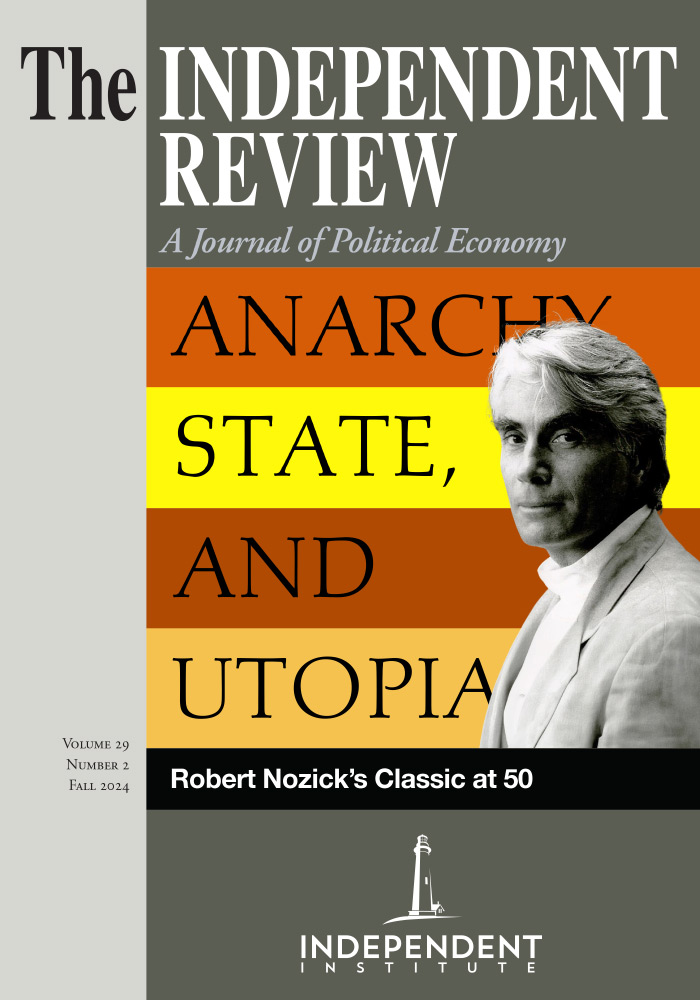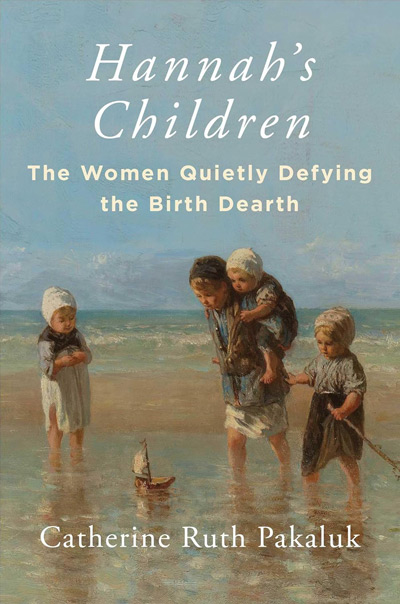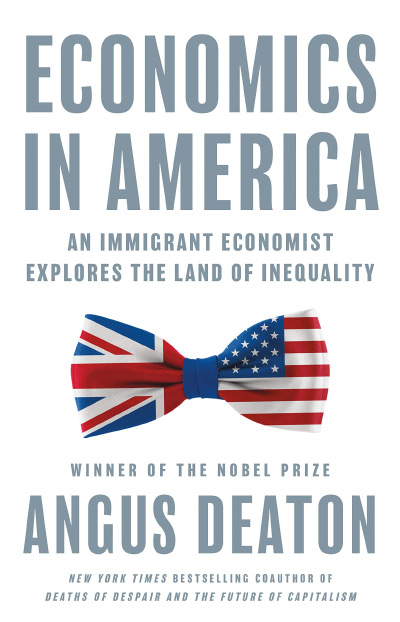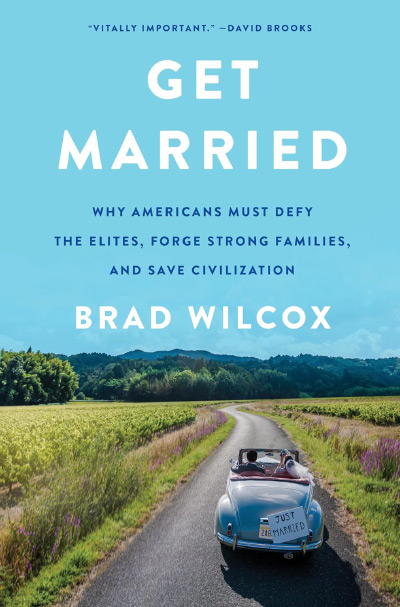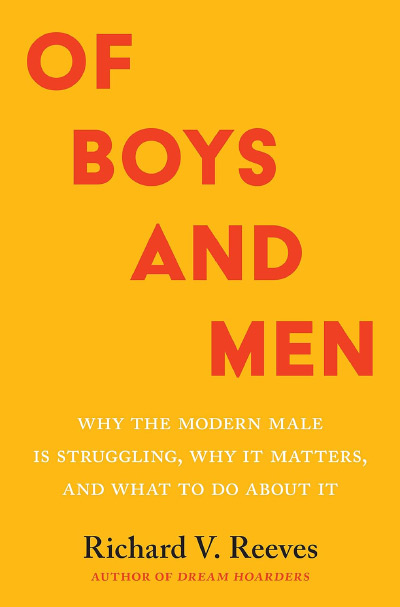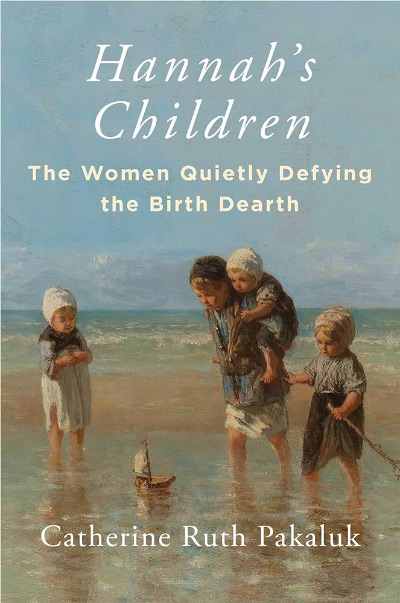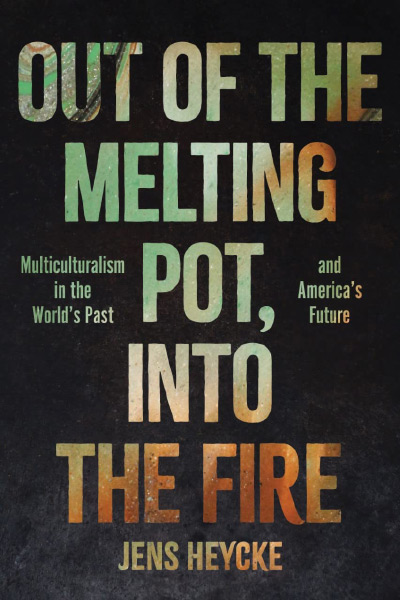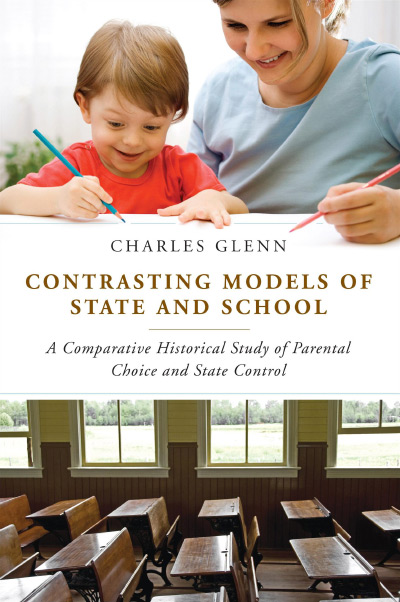In Hannah’s Children, Harvard-trained economist and mother of eight, Catherine Pakaluk, sets out to understand the motivations of the women quietly defying the trend of declining fertility rates in industrialized countries by interviewing fifty college educated women with five children or more. Her book beautifully summarizes the insights she gained, most importantly: (Wo)man cannot do or have everything. Pakaluk’s interviews reveal that the almost exclusive focus on career building and professional accolades in our educational institutions and the world more broadly has created an “attitude towards family planning, where children are fitted into our own lives, our own stories—our own plans for the future” (p. 152). As a result, women have fewer children than they really desire. Economic demographers call this the fertility gap. They also have their children later in life, when their own fertility becomes a constraint on family size. Women who do have more than the average number of children, on the other hand, “believed that the value of having children proved itself over time in ways that evaded human design and expectation” (p. 152). Catherine Pakaluk’s book reads like a breath of fresh air in this world which is otherwise largely silent on the joys and challenges of womanhood. It is a must read for any human, but probably especially educated young women who are considering and contemplating their own identity as women.
I personally wish this book had been written before I embarked on my own journey as wife and mother. Unlike Pakaluk, I waited to have children until I was a tenure-track assistant professor with a PhD in economics. In the twenty-one years of education I had received up until that point (which also spanned two different countries), no one except one middle-aged, white-haired, male German teacher had ever said a word to me about the trade-offs and challenges women who choose to be mothers confront. His advice stuck with me, probably because it was so different: it is difficult for women to navigate family and career. All I had heard up to this point and all I heard after were trite statements about gender equality, women's rights, and the ridiculously non-sensical “women can have it all.” Those feminist pronouncements proved useless and maybe even positively damaging when I was facing the actual trade-offs of parenthood and dual-career planning with my PhD economist husband. In retrospect, I guess I should have known better; I should have asked more questions of the women in my life who chose different paths, and I should have listened more carefully to them. Maybe I should have just applied my own education and realized that womanhood is no exception to the rule that tradeoffs are everywhere. As Pakaluk’s interviews demonstrate beautifully, the choice to be a wife and mother is costly, but clearly worth it.
Pakaluk is foremost an economist, which may be why her summaries of the interviews she conducted focus on the fact that having a child will come with costs. But, as she shows persuasively, the most important cost of having children is not the cash cost of expenses associated with raising children, which is usually the target of policy designed to increase fertility rates. Rather, it is the cost of career opportunities forgone and the cost of adopting changing narratives of self that seem to matter most and can also explain the change in demand for children over time. Those costs largely, although not exclusively, fall on women and, over the last century, this “opportunity cost of having a child increased sharply with women’s expanded education and professional work [opportunities]” (p. 147). As Pakaluk writes in chapter 12, which is titled “Cost and Choice” after James Buchanan’s seminal book (Cost and Choice: An Inquiry into Economic Theory, Indianapolis: Liberty Fund, 1999): “At the time of the choice, a couple must consider the entire bundle of the costs of having a child—and that bundle includes what else a woman might wish to do with her time, talents, and money. It’s a question of lifestyle affordability, career affordability, identify affordability” (p. 150).
But, and maybe more importantly, there are also significant benefits to embracing the lifegiving potential of womanhood. Many of the women Pakaluk interviewed expressed a sense of fulfillment in childbearing and their role as mother, describing it as “fulfilling to how I was made, or who I am” (p. 109). She quotes one mother as saying: “I have inner peace in my life that I didn't have then. I was searching. I'm not searching now” (p. 281). Pakaluk summarizes across the interviews she conducted that many of the women in her sample expressed that “their children had saved their lives, saved their marriages, and saved their souls. By their own accounts they had been saved from immaturity, loneliness, selfishness, and uselessness” (p. 54). Unfortunately, some of these benefits are tricky to assess in advance because children are, as Pakaluk writes, experience goods. One of her interviewees explains: “You can’t really know what it is until you experience it” (p. 67). Finally, unlike with most economic goods, the marginal benefits of additional children do not seem to be decreasing—at least not quickly—as Molly, a mother of five corroborates: “[Every child] keeps adding more color to the family. It’s always, ‘Like this is better, this is better again, it keeps getting better!’” (p. 161). In other words, more children came with more and greater benefits for the family and in some cases, much needed human connection in difficult times of loss, grief, and depression as the stories of Kyra and Maggie and their families in chapter 20 and 21 illustrate.
Unfortunately, as Pakaluk discusses in chapter 4, families seem to systematically get the calculus of the costs and benefits of childbearing wrong; “[a]chieved fertility tends to undershoot desired fertility” (p. 37) and, Pakaluk suggests, women bear the majority of the cost of this fertility gap in the form of declining female happiness. In part, the fertility gap may exist because children are experience goods but in part it may also be a result of the fact that narratives of womanhood and motherhood are underrepresented in the world today. In chapter 14, Pakaluk describes some dynamics that may be underlying this fertility gap: there is a real sense of betrayal among woman who choose to have children because they “have been encouraged to look at career-building single-mindedly [and] suddenly find themselves up against a gut-wrenching quandary they don't remember opting into—their desire for a home and children on the one hand, and the fruition of years of training on the other” (p. 191). Because career building is all we ever hear about, we are misled into having our children later in life and, as a result, we have fewer. We systematically choose careers without considering the opportunity cost of motherhood. When we finally do “turn on our fertility” and have children, we face a high cost of changing our narratives of who we are to accommodate woman and mother alongside our professional identity, which can be painful.
So, part of the problem underlying the birth dearth is that narratives of womanhood and motherhood are marginalized and drowned out by a chorus of post-modern idealism which delegitimizes those roles and denies both the concept of opportunity cost and human nature. The idea that being a mother can be extremely fulfilling in a way that few other things are, maybe because it fulfills our biological potential, is vilified and banished from public discourse except in religious contexts. Women in secular educational environments are not told that our role as mother, while costly, provides an opportunity to grow “into something better, or someone better” and that this “growth into true self depends on being stretched by one's role” in a way that is not always comfortable (p. 169). A wider awareness of this truth, however, is essential for any woman in her process of becoming who she wants to become, whether that includes children or not. The fact that women are discouraged from considering their lifegiving potential as valuable and valid creates a systematic misallocation of resources, an error that many women do not discover until much too late in life and at a high cost to themselves, their families, and society at large.
So, what can be done about the fact that narratives about marriage, motherhood, and womanhood are marginalized? Pakaluk suggests that public policy incentivizing births (like parental leave, incentive payments, and other types of policies) will do little to change the family calculus, because they fail to address the problem of high opportunity cost. Instead, she argues in the last chapter of her book, what is needed more than anything to combat the birth dearth is thick religious liberty that goes beyond freedom of worship. While not all of the women she interviewed cited religious reasons or motivations for their choice to defy the birth dearth, most did. So faith, while not a prerequisite for the choice to have more children, is at least a catalyst. Greater religious liberty, especially with respect to educational choice, would allow for competing narratives of womanhood to re-enter the educational environment and allow women to choose narratives of self that more accurately account for the reciprocal opportunity cost of motherhood and career. I could not agree more.
| Other Independent Review articles by Diana W. Thomas | ||
| Winter 2024/25 | Applied Humanomics: Introduction to the Symposium | |
| Spring 2024 | The Power of Hope: How the Science of Well-Being Can Save Us from Despair | |
| Spring 2024 | The Human Prosperity Project: Essays on Socialism and Free Market Capitalism from the Hoover Institution | |
| [View All (7)] | ||

